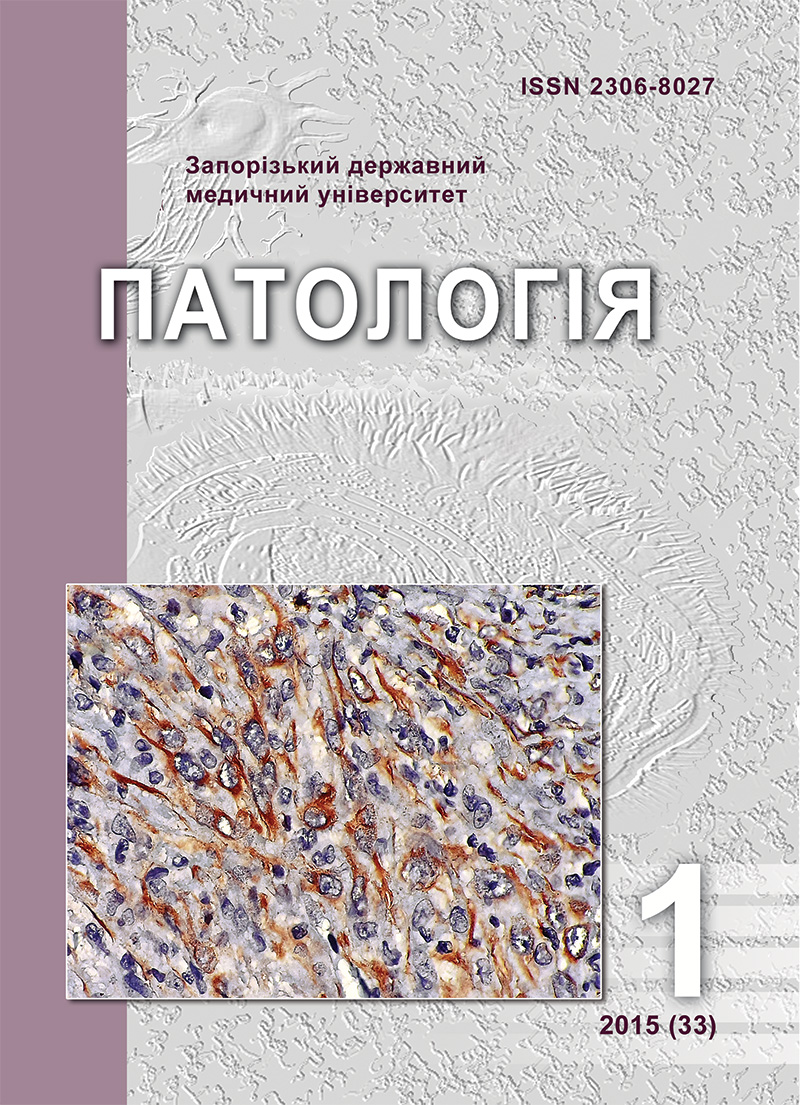Lectin-histochemical assessment of carbohydrate determinants in tumour cells of main histological types of gastric cancer
DOI:
https://doi.org/10.14739/2310-1237.2015.1.42932Keywords:
Stomach Neoplasms, Linitis Plastica, LectinsAbstract
Aim. 69 cases of gastric cancer were investigated, among them 31 cases of diffuse type, 25 cases of intestinal and 13 mixed-type, using lectins of eight specificities: wheat germ, peanut, edible snail, common elder, laburnum tree, soybeans, lentils and mistletoe.
Methods and results. Maximum frequency of the high lectin binding was found in the diffuse type for common elder (72.4%), edible snail and soybean lectins (67.7% each). Intestinal type of the gastric cancer was characterized by high rate of tumor cell binding to peanut lectins (52%) and wheat germ lectins (48%). In mixed type – with lectins of peanut and soybeans (53.8% each). Meanwhile lectins exhibiting high binding frequency are characterized by a more intensive binding in comparison with the normal mucosa in the same case. Cases of vascular invasion with tumour cells and without it were compared. In the intestinal type of the gastric cancer the maximum degree of staining difference was with edible snail and common elder lectins with the predominance in the group with invasion (26.4% and 20.2%, respectively). In the diffuse type of the gastric cancer, the highest frequency of intense binding was in the group with invasion with common elder (68%), edible snail (63%), laburnum tree (61.5%), and lentils lectins (57.8%). In the mixed type of the stomach cancer an intensive staining in the presence of vascular invasion was with peanut, soybean (53.8% each) and wheat germs lectins (42.2%).
References
Antoniuk, V. O. (2005) Lectyny ta ikh syrovynni dzherela [Lectins and its charge spring]. Lviv. [in Ukrainian].
Vasilenko, I. V., Bruk, B. B., Kondratyuk, R. B., Gulkov, Yu. K., & Surgaj, N. N. (2013) Posledovatel'nost' poyavleniya otdel'nykh priznakov e`pitelial'no-mezenkhimal'noj transformacii v osnovnykh gistologicheskikh tipakh raka zheludka [The sequence of appearance of certain signs of epithelial-mesenchymal transition of the main histological types of gastric cancer]. Ukrainskyi medychnyi almanakh, 3, 49–53. [in Ukrainian].
Vasilenko, I. V., Surgai, N. N., Vinnikov, Yu. M., Gulkov, Yu. K., Dyadyk, E. M., Kurennaya, S. S., et al. (2003) Rol' uglevodnykh determinant v invazivnom rake zheludka [Role of the submucouses determinant in invasion growth of a crawfish of a stomach]. Visnyk problem biolohii i medycyny, 1, 102–106. [in Ukrainian].
Lucik, A. D., Birov, V. V., & Dmitruk, I. M. (1986) [Lectin`s receptors in the breast and its carcinoma]. Arkhiv patologii, 7, 9–14. [in Russian].
Lucik, A. D., Detyuk, A. D., Lucik, M. D. (1989) Lektiny v gistokhimii [Lectins in histochemistry]. Lvov. [in Ukrainian].
Pashchenko, S. M. (2002) Vyznachennia v pukhlyni khvorykh na kartsynomu molochnoi zalozy retseptoriv do lektynu SNL [Detection receptors of the lectin SNL in breast cancer]. Odeskyi medychnyi zhurnal, 1, 50–53.
Arab, M. R., Salari, S., Karimi, M., & Mofidpour, H. (2010) Lectin histochemical study of cell surface glycoconjugate in gastric carcinoma using helix pomatia agglutinin. Acta Med Iran, 48(4), 209–213.
Chen, G., Zou, Q., & Yang, Z. (2010) Expression of galectin-3 and Sambucus nigra agglutinin and its clinicopathological significance in benign and malignant lesions of breast. Zhong Nan Da Xue Xue Bao Yi Xue Ban, 35(6), 584–589. doi: 10.3969/j.issn.1672-7347.2010.06.008.
Kannan, S., Lakku, R. A., Niranjali, D., Jayakumo, K., Steven, A. H., Taralakshmi, V. V., et al. (2003) Expression of peanut agglutinin-binding mucin-type glycoprotein in humar eosophageal squmous cell carcinoma as a marker. Mol Cancer, 2(1), 38. doi:10.1186/1476-4598-2-38.
Murakami, Y., Hasegawa, Y., Nagano, K., & Yoshimura, F. (2014) Characterization of wheat germ agglutinin lectin-reactive glycosylated OmpA-like proteins derived from Porphyromonas gingivalis. Infect Immun, 82(11), 4563–4571. doi: 10.1128/IAI.02069-14. E
Nieto, M. A. (2002) The SNAIL superfamily of zink – finger transcription factors. Molecular cell biology, 3, 155–166. doi:10.1038/nrm757.
Sata, T., Roth, J., Zuber, C., Stamm, B., & Heitz, P.U. (1991) Expression of alpha 2,6-linked sialic acid residues in neoplastic but not in normal human colonic mucosa. A lectin-gold cytochemical study with Sambucus nigra and Maackia amurensis lectins. Am J Pathol, 139(6), 1435–1448.
Shang, C., & Van Damme, E. J. (2014) Comparative analysis of carbohydrate binding properties of Sambucus nigra lectins and ribosome-inactivating proteins. Glycoconj J, 31(5), 345–354. doi: 10.1007/s10719-014-9527-9.
Silva, M. L., Gutiérrez, E., Rodríguez, J. A., Gomes, C., & David, L. (2014) Construction and validation of a Sambucus nigra biosensor for cancer-associated STn antigen. Biosens Bioelectron, 57, 254–261. doi: 10.1016/j.bios.2014.02.006.
Ura, H., Denno, R., Hirata, K. Yamaguchi, K., Yasoshima, T., & Shishido, T. (1997) Close correlation between increased sialyl-Lewis-x expression and metastasis in human gastric carcinoma. World J Surg. 21(7), 773–776.
Yang, L. P., Jiang, S., Liu, J. Q., Miao, X. Y., & Yang, Z. L. (2012) Up-regulation of galectin-3 and Sambucus nigra agglutinin binding site is associated with invasion, metastasis and poor-progression of the gallbladder adenocarcinoma. Hepatogastroenterology, 59(119), 2089–2094.
Zhou, J. P., Yang, Z. L., Liu, D. C., & Zhou, J. P. (2009) Expression of galectin 3 and Sambucus nigra agglutinin and their clinicopathological significance in benign and malignant lesions of stomach. Zhonghua Wei Chang Wai Ke Za Zhi, 12(3), 297–300.
Downloads
How to Cite
Issue
Section
License
Authors retain copyright and grant the journal right of first publication with the work simultaneously licensed under a Creative Commons Attribution License that allows others to share the work with an acknowledgement of the work's authorship and initial publication in this journal.



